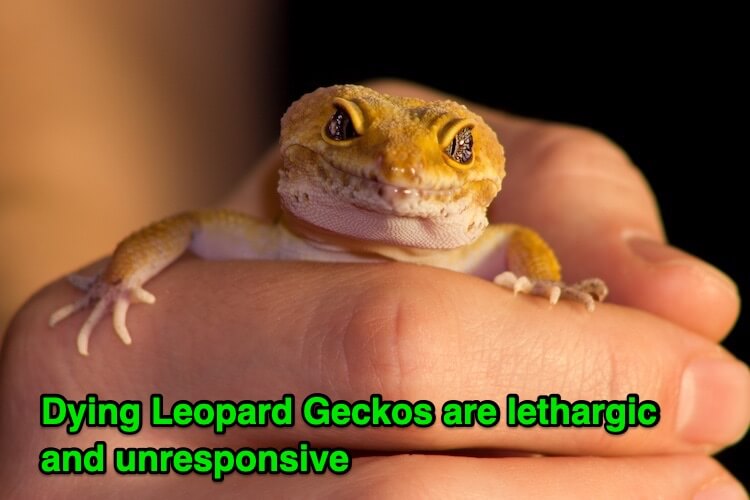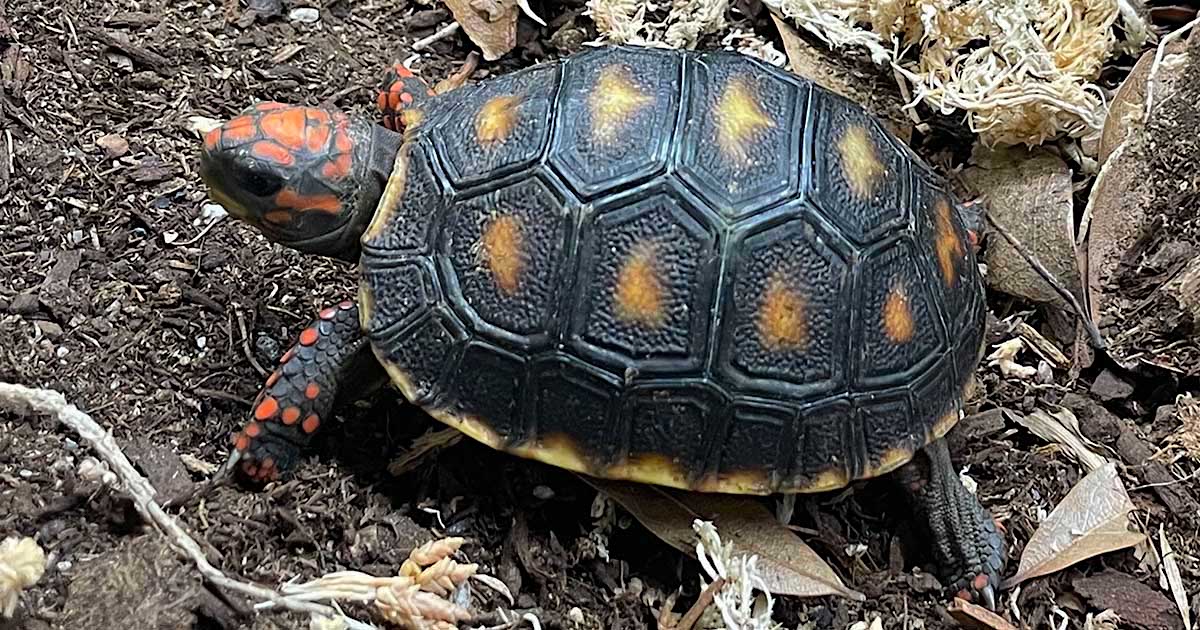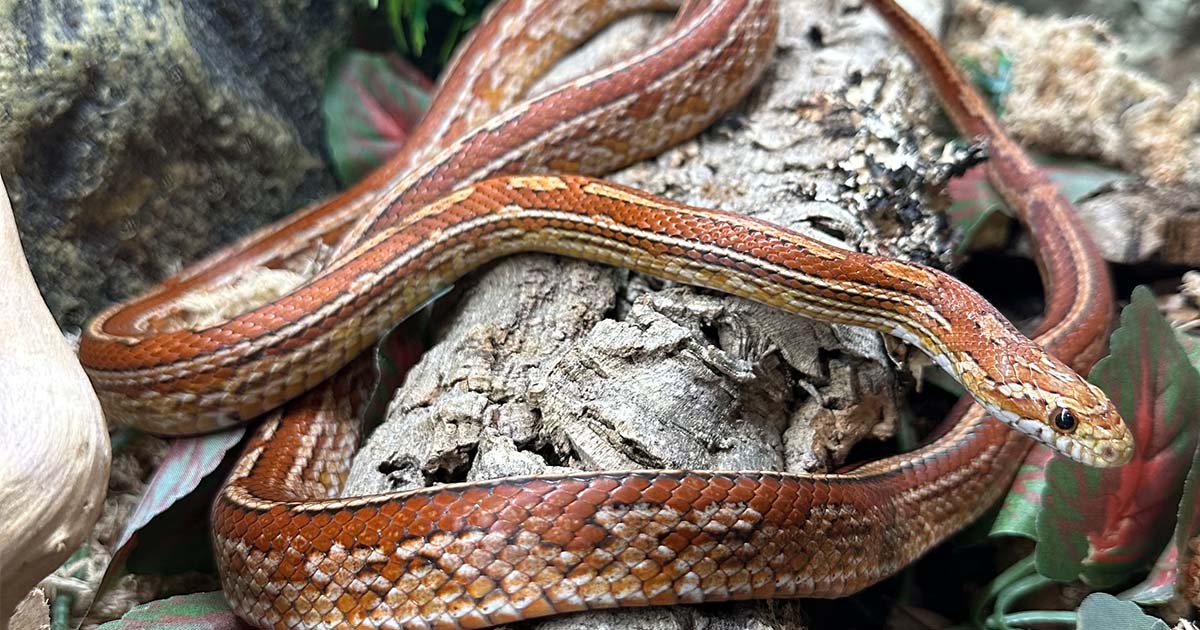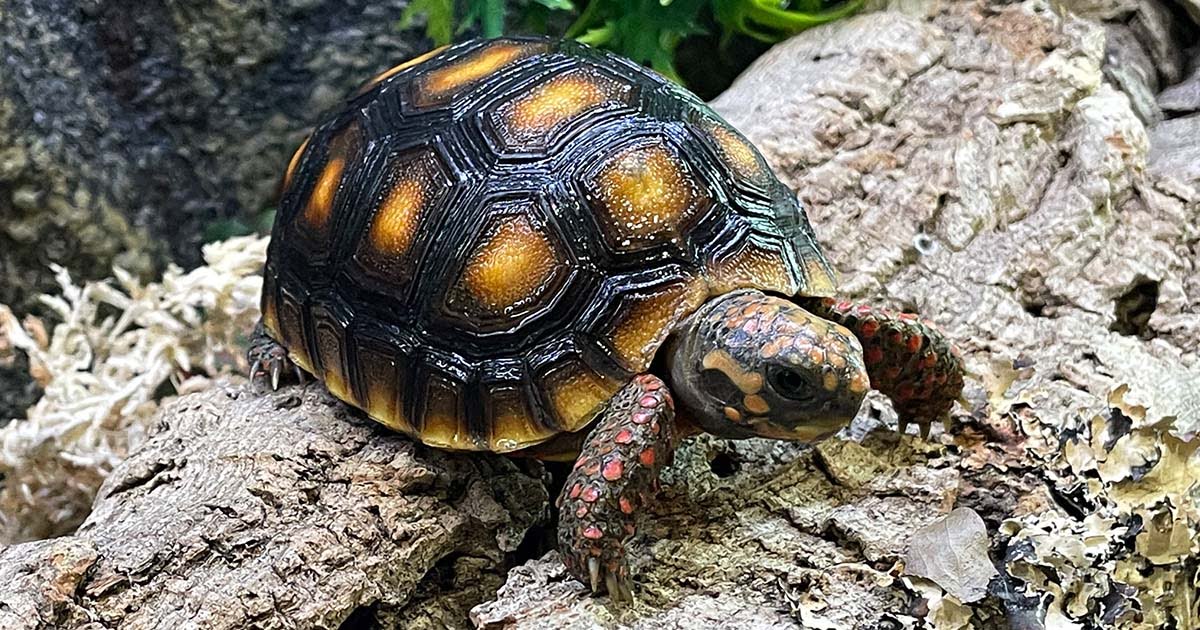Caring for a Leopard Gecko is a fun and rewarding experience. They provide years of entertainment, companionship, and education.
Yet, all good things must come to an end. Leopard Geckos don’t live forever.
Over 15 years of keeping Leopard Geckos, I have had one euthanized and two pass away on their own from old age. Recognizing the signs a Leopard Gecko is dying can help make their passing easier, for both them and you.
Though it is not an easy topic to discuss, it is important to know about what you can do.
What to Know
- Dying Leopard Geckos are typically lethargic and unresponsive. They often become dull and colorless, in addition to losing weight and refusing food. After death, they quickly grow cold and stiff.
- Improper husbandry is the number one cause of death in Leopard Geckos.
- Dying geckos should not be handled unless absolutely necessary. Handling can stress them out more and make the process more difficult.
- Typically, old Leopard Geckos will decline in health and pass away within a week or so.
- Leopard Geckos reach old age between 10 and 20 years, with an average lifespan of 15 years old. Good care, housing, and a healthy diet all help them to live longer, healthier lives.
Signs A Leopard Gecko Is Dying
| Cause | Sign | Timeline |
|---|---|---|
| Rapid Weight Loss | Extreme weight loss (a third of body weight). | Within just a few days. |
| Sunken Eyes | The eyes of dying geckos sit deeper than normal because of dehydration. | Usually 1-2 days before death. |
| Appetite Loss | A sudden loss of appetite. | Loss of appetite can happen about 1-2 weeks prior to death. |
| Unusual Poop | An absence of poop. | About a week before death. |
| Thin Tail | Tail thinner than a pencil. | A matter of days. |
| Dull colour | Rapid color loss to a dull or muddy brown | Usually 1-2 days before death. |
| Lethargy | Constant sleeping, even after dark. | A few months before death. |
| Dak Patch | A dark brown, green, or reddish patch that appears suddenly on their belly. | About a week before death. |
| Unusual Body Bending | Arching its back or standing on its tiptoes | A few months before death. |
| Mucus or Discharge | Mucus, discharge, or bubbly saliva around their mouth and nose. | About one month before death. |
| Bony Appearance | Leg joints that look sharper than they used to, or head and jaws which are slightly uneven. | About one year before death. |
1. Rapid Weight Loss
Leopard Geckos are naturally chunky lizards.
The weight of a healthy adult should not fluctuate noticeably.
A full-grown adult can weigh anywhere between 50 and 100 grams, depending on its length, gender, and genetics.
Rapid weight loss is a sign that a Leopard Gecko is very sick or dying. When my old gecko was near death, she visibly lost weight over the course of just a few days. Though I didn’t weigh her, I estimated that she lost nearly a third of her original body weight.
Weight loss is a common occurrence in dying Leopard Geckos, especially elderly ones.
In most cases they lose weight because they stop eating. If your lizard is eating, but still losing weight, it may have a parasitic infection.
2. Sunken Eyes
A Leopard Gecko that is close to passing away will have sunken-in eyes.
Sunken eyes are caused by dehydration.
When a gecko feels that it is near the end of its life, it will often stop eating and drinking. The resulting dehydration causes its eyes to take on a sunken appearance.
This symptom often occurs within 1-2 days of death and is especially prominent after dying.
Usually, their eyes protrude from their heads. The eyes of dying geckos seem to sit deeper than normal.
3. Appetite Loss
Leopard Geckos that are dying from old age generally stop eating.
A sudden loss of appetite, combined with some other signs I’ve described in this article, can be a sign that their bodies are winding down. They generally refuse food about 1-2 weeks prior to death.
Appetite loss is not always a sign of death. It can be a sign of a lot of things:
- Brumation
- Illness
- Ovulation
- Low temperatures
- Shedding
In younger geckos, anorexia is often a symptom of a curable illness or husbandry problem.
Geckos that stop eating will stop pooping as well…
4. Unusual Poop
Dying geckos usually stop pooping about a week before death.
On average normal adults poop 2-3 times per week, or once a day if they are juveniles. Normal poop should have a solid brown part and a smaller, chalky white part.
Runny, foul-smelling poop is a warning sign that something is not right.
An adult that hasn’t pooped in five days or more is having a problem eating or digesting insects.
5. Thin Tail
When Leopard Geckos are dying they often lose the fat they have built up in their tails. This usually occurs alongside other weight loss but a thin tail is easier for you to see.
Leopard Geckos with tails thinner than a pencil often are very close to death.
These lizards use their tails to store fat for times of famine in the wild. A healthy individual will have a full, plump tail.
A thin tail, especially one that becomes thin in a matter of days, is a bad sign.
6. Dull Color
A loss of color is something I have experienced in sick and dying Leopard Geckos.
I remember taking my first gecko to be euthanized for kidney problems. He was already more faded than usual, but he quickly lost more color and became a dull, grayish brown.
Rapid color loss can be tricky to recognize.
Bright color morphs like hypos fade to a muddier brown, yellow, or orange when dying. This color change is different from the change seen during shedding. When about to shed, these lizards turn papery white, instead of dull brown.
7. Lethargy
Sick and dying Leopard Geckos often sleep constantly, even after dark.
As reptiles reach the end of their lives, they slow down considerably and become lethargic. Sometimes, dying lizards will barely react to noises or movement.
If you know your Leopard Gecko is dying, you might also notice that it picks a certain hide or part of its tank to sit in and not move.
Lethargy is more noticeable at night, when healthy geckos are supposed to be active.
8. Dark Patches
Dark patches on a Leopard Gecko should be taken very seriously.
A dark brown, green, or reddish patch that appears suddenly on their belly is a sign of internal bleeding. Internal bleeding is most often caused by impaction as a result of improper substrate.
If you notice a dark patch, where there wasn’t one before, take your lizard to the vet immediately. Lizards with internal bleeding may only have less than a week to live without intervention.
I highly recommend not using sand as a substrate because of the high risk of impaction and internal bleeding.
9. Unusual Body Bending
If your Leopard Gecko is arching its back, standing on its tiptoes, or repeatedly bending its body in an unusual way, it may be trying to tell you that something is wrong. These kinds of body language are used to express pain and discomfort.
Arching the back can signify pain from a gut impaction.
Author Tip: Paying attention to your Leopard Gecko’s behavior from day to day, and noticing a sign of discomfort, could potentially save their life!
10. Mucus or Discharge
Sick Leopard Geckos may die if not taken to a vet for treatment.
Mucus, discharge, or bubbly saliva around their mouth and nose are symptoms of a serious respiratory problem like respiratory failure, stomatitis (mouth rot), and pneumonia. These symptoms are commonly accompanied by open-mouthed and raspy breathing.
If left untreated, these symptoms can be a sign that your Leopard Gecko is close to death.
Discharge around a gecko’s mouth and nose should be addressed by a vet immediately.
11. Bony Appearance
In my experience, Leopard Geckos gradually take on a bonier appearance as they age. You might notice their leg joints look sharper than they used to, or their head and jaws are slightly uneven.
These subtle differences become more pronounced as they near the end of their life.
A Leopard Gecko with visible bones is either very old, near the end of its life, or dangerously underfed.
Rapid weight loss can also make your lizard look excessively bony.
How Long Can It Take?
Leopard Geckos are typically very hardy and don’t experience many health problems. This is one of the reasons why they make one of the best and easiest pet lizards. However, they are still vulnerable to diseases, parasites, and other health problems that can lead to death.
Even with great care, all Leopard Geckos will eventually die once they reach old age.
The time it takes a Leopard Gecko to die depends heavily on the cause of death.
Some health problems can cause them to die very quickly.
Impaction is one of the top causes of sudden death in Leopard Geckos. Lizards affected with impaction will stop pooping and may lick their cloaca (or vent). In some cases, a dark blotch will appear on their bellies or sides. Once this symptom occurs, the affected reptile will likely die in the next few days to a week.
Dietary causes of death are usually long-term and can take several months.
Leopard Geckos suffering from a nutritional deficiency become weak, lethargic, and have softened limbs (in the case of a calcium deficiency) or eye and mouth problems (in the case of a vitamin A deficiency).
If all goes well, your lizard may simply die of old age.
From my experience, old Leopard Geckos remain relatively active and healthy up until a few weeks before death. All of a sudden, you might find your elderly gecko sleeping a lot more than usual, eating less, and becoming less responsive. From this point, they will gradually decline for a few weeks until they pass away.
4 Ways To Tell If A Leopard Gecko Has Passed
Reptiles are naturally cold-blooded and often sleep during the day. This means it can be hard at first glance to tell if your Leopard Gecko has died.
One of the first and most obvious signs is unresponsiveness.
If your Leopard Gecko is asleep, a light touch or nearby noise will wake them up. You should see their eyes open or their head move. Even sick individuals should respond to being touched. A dead Leopard Gecko will not make any movements when touched or picked up.
A second sign to test for rigor mortis.
If you gently move their limbs, head, and tail, but they feel stiff, they have passed away.
Rigor mortis is a process that occurs after death in animals and causes the joints and muscles to become stiff. I have seen this occur in as little as 10 minutes after death in Leopard Geckos, though it can sometimes take as long as three hours.
A third, and more subtle sign of death in Leopard Geckos, is a loss of color.
Leopard Geckos who are dying, or dead, have a duller and more faded appearance. I have noticed this color change is especially drastic in geckos that die from an illness, instead of old age.
Finally, as with all animals, Leopard Geckos will stop breathing when dead. This can be a little tricky to spot, since they naturally have very slow, shallow breaths when sleeping.
Sit quietly and watch your gecko’s upper ribcage from just behind the front arms. If you don’t see any movement in 45 seconds to 1 minute, you Leopard Gecko has passed on.
Final Thoughts
The grieving process is a sad, but unavoidable part of owning such a wonderful pet lizard.
It took me several weeks to fully process the death of my first Leopard Gecko. I had owned her for 12 years and was very attached. I found it was helpful to look back at pictures I had taken of her throughout her life to remember the good memories.
After your Leopard Gecko has died, it is important to take time for yourself.
If your pet dies from husbandry mistakes or an accident, learn from the experience, but don’t be too hard on yourself. After all, we all have things we can improve on and do better.



